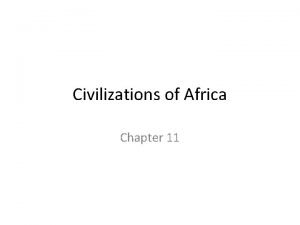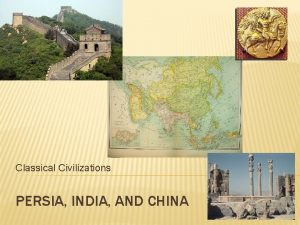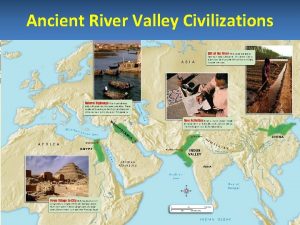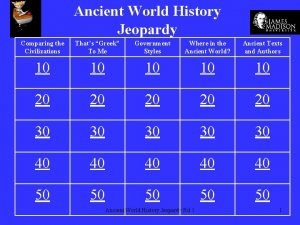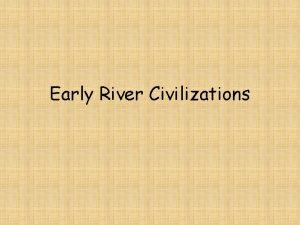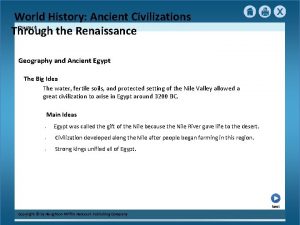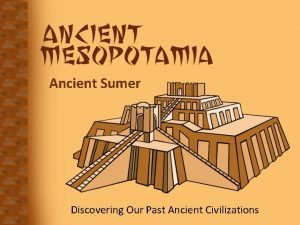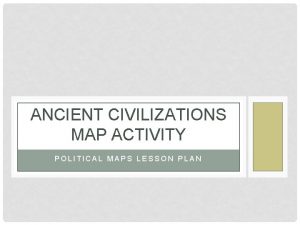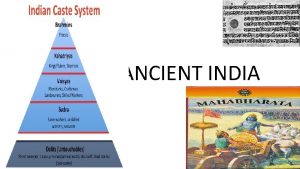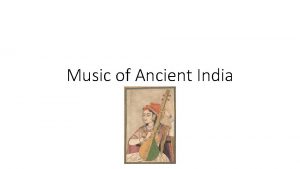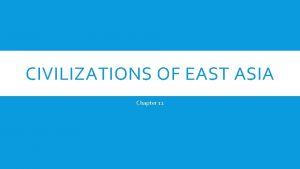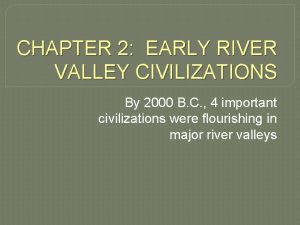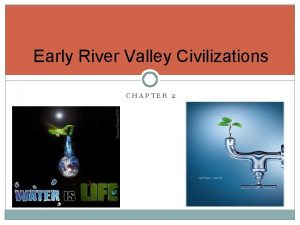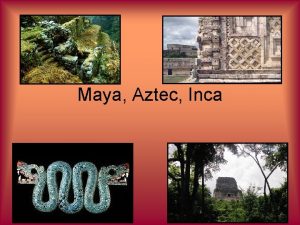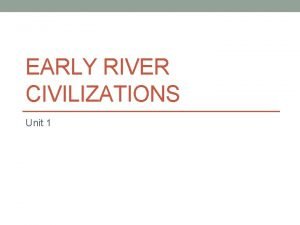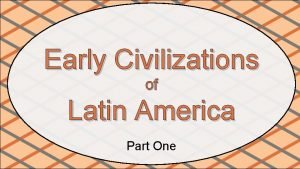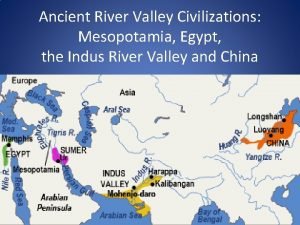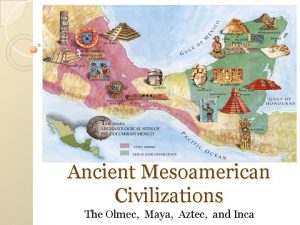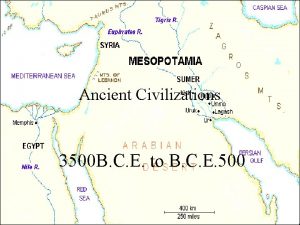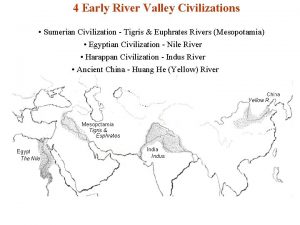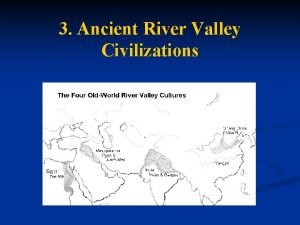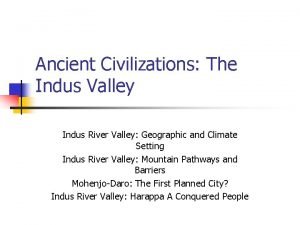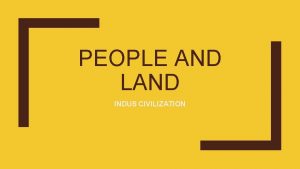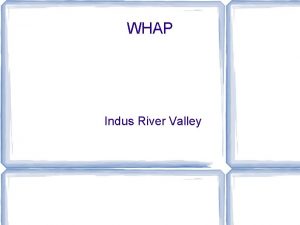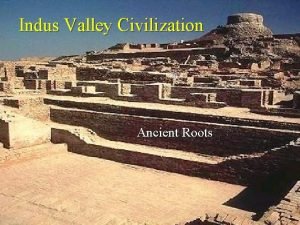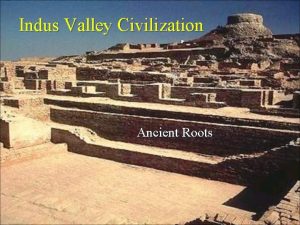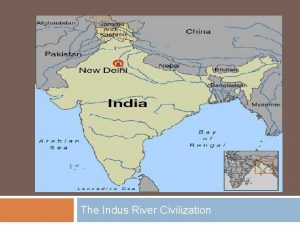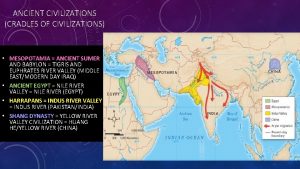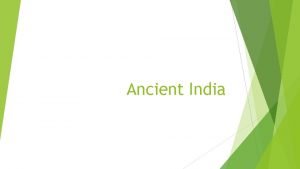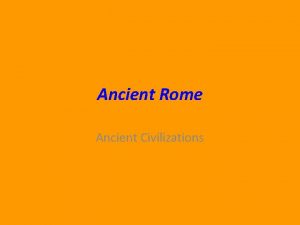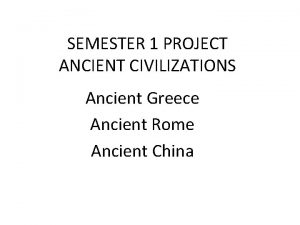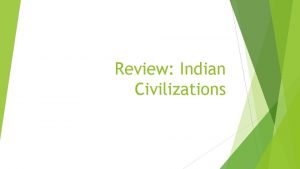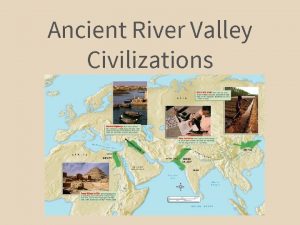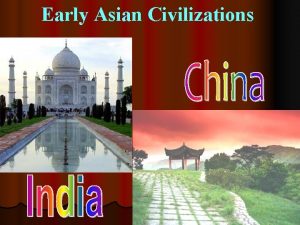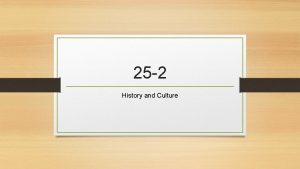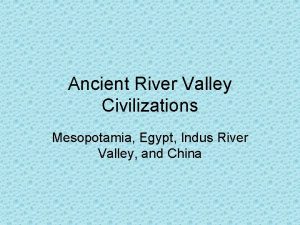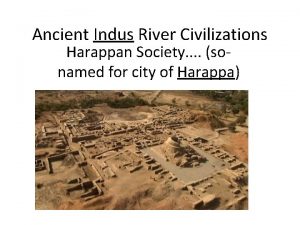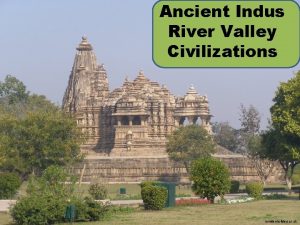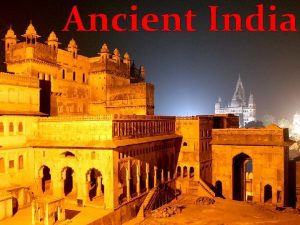CHAPTER 3 ANCIENT INDIAN CIVILIZATIONS Section 1 Indus






























- Slides: 30

CHAPTER 3 – ANCIENT INDIAN CIVILIZATIONS Section 1: Indus River Valley Civilizations

Section One Essential Questions 1. 2. What role did geography and climate play in the settlement of the Indian subcontinent? How did people in the first Indus River valley civilization live?


India

Physical features: India is separated from the rest of Asia by the Himalayas (kept out invaders) Two great rivers: Ganges River (through fertile valley) Indus River (through drier plain)

Harappan civilization: Arose in Indus River valley around 2500 BC and lasted through 1500 BC (same time as Egypt’s Old and Middle Kingdoms) Harappa and Mohenjo Daro were the two major cities of the region Mohenjo Daro translates as “Mound of the Dead” Citadel was strong central fortress in both cities


Both cities were large and carefully planned Had public baths, brick sewers, and some two-story homes had bathrooms Had irrigation canals and ditches

Mohenjo-Daro This map shows the layout of Mohenjo. Daro, one of the principal cities of the Indus Valley civilization. The larger eastern area contained the residential and commercial sections of the city, which were laid out in a grid of large rectangular blocks. Rising more than twenty feet to the west stood the citadel, built on a mound of mud brick and rubble. Fortified by a brick wall and towers, the citadel contained the city’s shrine, assembly hall, baths, and granary.

Technology: Storehouses for grains could hold food for 35, 000 people Ability to store and distribute surplus food shows strong central government Evidence of writing from 2300 BC Can’t decipher it Most are personal seals with names on them

Religion: No temples, shrines, or religious writings have been found May have held rituals in homes or outdoors Buried their dead in wooden coffins along with many pottery vessels that were probably filled with food for the afterlife Most people were buried with some simple jewelry, such as shell or copper bracelets and agate beads Elaborate ornaments of gold, silver and precious stones were never included in burials and must have been kept by the living relatives

Economy: Rich farmland around cities – grew cotton, wheat, barley, rice and raised cattle, sheep, pigs, and goats Traded with Mesopotamia by 2300 BC Made cloth, pottery, bronze items, gold and silver jewelry

Disappearance Unsure as to why they disappeared around 1700 BC Floods, violence, or an earthquake are all ideas Several complete skeletons were found People appear to have abandoned their homes and possessions

Section Two Essential Questions 1. 2. How did life in northern India change with the coming of the Indo-Aryans? What were the major contributions of the Indo -Aryans to Indian society?

Indo-Aryans Nomads from the North who established Indian civilization around 1750 BC We know about them through their religious writings called Vedas Aryans today are called Indo-Europeans and Indo-Iranians, depending on location Indo-Aryans brought new religion (Hinduism) and a new language (Sanskrit) to northern India The word Aryan has to do with ancestry and language group Hitler misused this word to his own benefit, to try to show “pure” roots of his people

They also brought the idea of the caste system Distinct social classes appeared in Indian society People were not able to move classes after birth The fifth class was the Untouchables – garbage collectors, movers of dead bodies, etc. Farming provided a living for people in the North Trade provided a living for people in the South Silk, cotton, wool, ivory, spices, gems To Far East, SW Asia, Africa, and Europe

Indian Caste System

Section Three Essential Questions 1. 2. 3. How important was religion in ancient Indian society? What were the principal elements of Hinduism? What were the basic beliefs of Buddhism?

Hinduism India’s major religion We know about Hinduism through religious writings called the Vedas Teaches that the world we see is an illusion Believe in reincarnation of souls Ultimate goal is nirvana – a perfect peace The Hindus have a trinity of gods – Brahma, Vishnu, and Shiva. Brahma is the creator, Vishnu is the preserver and Shiva is the destroyer. The daily alternation of light and dark is caused by Brahma. This picture shows Vishnu and Shiva.

Is Hinduism polytheistic? Hinduism worships multiple forms of one god Hindus believe in monotheistic polytheism Pantheism is the view that god is everything and everyone and that everyone and everything is god. Your book calls it Monism (a single reality) A tree is god, a rock is god, an animal is god, the sky is god, the sun is god, you are god, etc.

Hinduism has grown to become the world's third largest religion, after Christianity and Islam. It has about 950 million followers -- about 14% of the world's population.

Buddhism Founded by Siddhartha Gautama (Buddha) in India around 500 BC Accepted some Hindu ideas, including reincarnation Taught that ethics are more important than ceremonies Believed “desire causes suffering” Believed that anyone, regardless of caste, could reach nirvana

Is Buddhism polytheistic? Buddha was a teacher, not a god They honor Buddha for bringing ultimate wisdom Buddhism does not depend on the existence of a god who created the universe Buddhism is neither monotheistic nor polytheistic Buddha did not rule out the existence of a god or gods altogether Today, Buddhists talk about a large number of Divine Beings

There are estimated to be around 350 million Buddhists worldwide (6% of the world's population). This makes Buddhism the world's fourth largest religion.

• The Golden Buddha is the world's largest solid gold statue, with a weight of 5. 5 tons. • It is located in the temple of Wat Traimit in Bangkok, Thailand.



SECTION 5: ANCIENT INDIAN LIFE AND CULTURE

Section Five Essential Questions 1. 2. In what ways were women’s rights limited in ancient Indian society? What were the most important cultural achievements of the Gupta period?

Ancient Indian Life and Society Polygyny was accepted – men had more than one wife Children of higher castes were educated in literature, astronomy, math, warfare, government Studied math, medicine, and astronomy in great detail Lower castes educated in crafts and trade Indians were advanced in studying medicine Understood importance of spinal cord Developed technique of inoculation Knew about cleanliness and disinfecting wounds
 Chapter 11 section 1 early civilizations of africa
Chapter 11 section 1 early civilizations of africa Ancient river valley civilizations map
Ancient river valley civilizations map Ancient india lesson 1 early civilizations
Ancient india lesson 1 early civilizations The two classical civilizations of ancient india were the
The two classical civilizations of ancient india were the Ancient river valley civilizations powerpoint
Ancient river valley civilizations powerpoint Ap world jeopardy
Ap world jeopardy Tigris euphrates and nile river
Tigris euphrates and nile river World history ancient civilizations through the renaissance
World history ancient civilizations through the renaissance Discovering our past ancient civilizations
Discovering our past ancient civilizations Ancient civilizations map activity
Ancient civilizations map activity The famous _____ blades were made of wootz steel.
The famous _____ blades were made of wootz steel. Ancient indian music
Ancient indian music Ancient religious art
Ancient religious art Chapter 11 civilizations of east asia
Chapter 11 civilizations of east asia Similarities between inca maya and aztec
Similarities between inca maya and aztec Chapter 2 early river valley civilizations
Chapter 2 early river valley civilizations Chapter 2 early river valley civilizations
Chapter 2 early river valley civilizations Chapter 26 civilizations in crisis the ottoman empire
Chapter 26 civilizations in crisis the ottoman empire Communication in ancient time
Communication in ancient time Ancient india vs ancient china
Ancient india vs ancient china Tower cabinet v ingram
Tower cabinet v ingram Consideration sec 2d
Consideration sec 2d Indian ipc section
Indian ipc section Map of aztec maya and inca
Map of aztec maya and inca Ancient river valleys map
Ancient river valleys map Inca diorama
Inca diorama 4 river valley civilizations
4 river valley civilizations Where did the olmec live
Where did the olmec live 3500 bc civilizations
3500 bc civilizations River valley civilizations map
River valley civilizations map River valley civilizations definition
River valley civilizations definition
